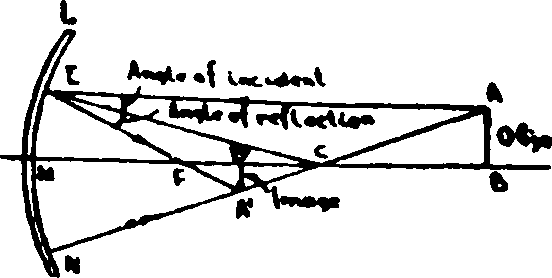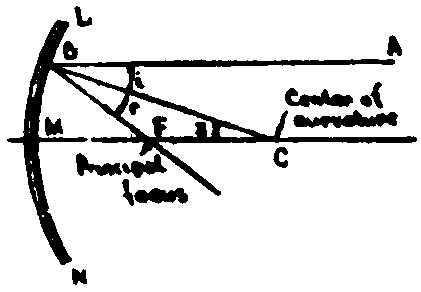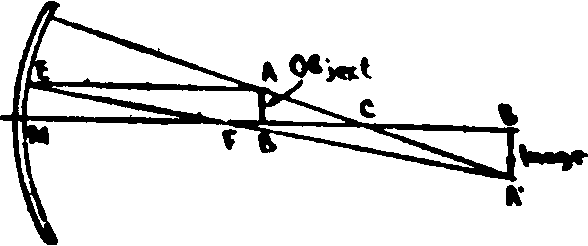
- •Reflection of light
- •Image in a Plane Mirror.
- •Reflection of light at an opaque surface
- •III. Answer the questions:
- •II. Answer the questions:
- •II. Answer the questions:
- •Principal focus
- •Construction of images in a concave mirror
- •Construction of images in a convex mirror
- •Parabolic mirrors
- •I. Translate and memorize:
- •II. Answer the questions:
- •I. Answer the questions:
- •II. Translate and memorize:
- •Polarisation
- •I. Answer the questions:
- •II. Translate and memorize:
- •Double reflection
- •II. Translate and memorize:
- •Nicol prism
- •I. Answer the questions:
- •Interference
- •Diffraction
Principal focus
In case of the luminous point such as U (Fig. 4) being removed very far from the mirror which results in the rays that reach the mirror being nearly parallel, the light after reflection comes to a single point which is easy to locate by observing the image of the sun produced by the mirror.
The point halfway between the mirror and its center of curvature at which all the rays parallel to the principal axis meet after reflection is known as the principal focus (Fig. 5).
Where a spherical mirror of large aperture is to be used we have to deal with an imperfection known as spherical aberration for the rays parallel to the axis do not all meet at the principal focus, though that imperfection is not great when the concave mirror is but a small part of the sphere. Parabolic mirrors are an advantage where the use of large mirrors is unavoidable for they enable us to overcome the above imperfection (aberration).
Fig. 5 Principal focus of a concave mirror. |
Fig. 6 Object between the center of curvature and the focus. The image is real, inverted and enlarged. |
Construction of images in a concave mirror
It is not difficult to construct the image of an abject AB placed in front of a concave mirror provided the center of curvature of the latter and its principal focus are given.
There may arise three cases to be considered: 1) that of the object lying beyond the center of curvature, 2) of its being between the center of curvature and the principal focus, and 3) that of the object being between the principal focus and the mirror.
Suppose that AB (Fig. 6) lies outside the center of curvature of the mirror. From A draw a ray parallel to the principal axis which after reflection will pass through the principal focus F. Now from A draw another ray through the center of curvature. The latter ray will be reflected back on itself and pass again through the center of curvature. Where these two rays intersect there will be formed an image of the point A. similarly, the image of any other point of the object AB may be located in this way: it follows that the image of AB is found to be A'B'.
If the object is between the center of curvature and the principal focus (Fig. 7) the rays are drawn as in the preceding case, and the result is similar, except that now the image is found to lie behind the center of curvature and be magnified. This may be shown in a very simple way. Let AB be the object lying between the principal focus and the center of curvature. From A draw the ray AE parallel to the principal axis, which is to pass through the principal focus F after being reflected.
Through the center of curvature draw the ray AC; the latter is
reflected back on itself and intersects the ray reflected from E at
A', thus forming an image of A at that

Fig. 7 Location of images in a concave mirror.
The image is real, inverted and diminished.
point. In a similar manner the images of the other points on the object (arrow) AB are found giving A'B' as the both magnified and inverted image of AB.
When we have to consider the case of the object being inside the principal focus (Fig. 8), the ray from A parallel to the principal axis is drawn just as in the above two cases, which results in its also passing through the principle focus after reflection. Consequently, the ray ABC through the center of curvature strikes the mirror normally thus being reflected back through C. These reflected rays EC and DF diverge and seem to have come from a point A' behind the mirror.
There is thus formed behind the mirror an image of A at A' where these two rays, when extended backward, intersect. Locating the images of the other points of AB in a similar way, we have behind the mirror the image A'B' of the object (arrow) AB, which we find to be erect and magnified one, but in this case it appears to lie behind the

Fig. 8 Object inside of the focus.
The image is virtual, upright and enlarged.
mirror. It is called a virtual image for light only appears to come from it, though to an eye in front of the mirror the effect is the same as if the rays actually came from the image A'B'.


